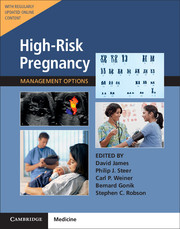Book contents
- Frontmatter
- Contents
- List of Contributors
- Preface
- Section 1 Prepregnancy Problems
- Section 2 Early Prenatal Problems
- Section 3 Late Prenatal – Fetal Problems
- 9 Prenatal Fetal Surveillance
- 10 Fetal Growth Disorders
- 11 Disorders of Amniotic Fluid
- 12 Fetal Hemolytic Disease
- 13 Fetal Thrombocytopenia
- 14 Fetal Cardiac Arrhythmias
- 15 Fetal Cardiac Abnormalities
- 16 Fetal Craniospinal and Facial Abnormalities
- 17 Fetal Genitourinary Abnormalities
- 18 Fetal Gastrointestinal and Abdominal Abnormalities
- 19 Fetal Skeletal Abnormalities
- 20 Fetal Tumors
- 21 Fetal Hydrops
- 22 Fetal Death
- Section 4 Problems Associated with Infection
- Section 5 Late Pregnancy – Maternal Problems
- Section 6 Late Prenatal – Obstetric Problems
- Section 7 Postnatal Problems
- Section 8 Normal Values
- Index
20 - Fetal Tumors
from Section 3 - Late Prenatal – Fetal Problems
- Frontmatter
- Contents
- List of Contributors
- Preface
- Section 1 Prepregnancy Problems
- Section 2 Early Prenatal Problems
- Section 3 Late Prenatal – Fetal Problems
- 9 Prenatal Fetal Surveillance
- 10 Fetal Growth Disorders
- 11 Disorders of Amniotic Fluid
- 12 Fetal Hemolytic Disease
- 13 Fetal Thrombocytopenia
- 14 Fetal Cardiac Arrhythmias
- 15 Fetal Cardiac Abnormalities
- 16 Fetal Craniospinal and Facial Abnormalities
- 17 Fetal Genitourinary Abnormalities
- 18 Fetal Gastrointestinal and Abdominal Abnormalities
- 19 Fetal Skeletal Abnormalities
- 20 Fetal Tumors
- 21 Fetal Hydrops
- 22 Fetal Death
- Section 4 Problems Associated with Infection
- Section 5 Late Pregnancy – Maternal Problems
- Section 6 Late Prenatal – Obstetric Problems
- Section 7 Postnatal Problems
- Section 8 Normal Values
- Index
Summary
Introduction and General Approach
Fetal tumors are rare, but can be associated with serious fetal morbidity and mortality. Recent technologic advances in ultrasound imaging and fetal magnetic resonance imaging (MRI) have made antenatal detection possible. Early detection has significant implications for maternal and fetal wellbeing. Once a fetal neoplasm is identified or suspected, a management strategy should be formulated based on the presumptive diagnosis and the prognosis for the lesion in question. An understanding of the ultrasonographic appearance of specific lesions, the differential diagnosis, available treatment modalities, including advanced delivery modalities, and overall prognosis is critical in providing families with accurate information. A multidisciplinary team, with representatives from maternal–fetal medicine, neonatology, pediatric hematology–oncology, and pediatric surgery, provides an excellent source of information for the parents and allows for an integrated approach.
The prevalence of fetal tumors is difficult to estimate, because of variations in the definition of congenital tumors prior to the near-universal application of ultrasonography. Historically, studies included only those tumors apparent at birth or diagnosed within the first 2–3 months of life. Furthermore, tumors found in stillbirths and nonmalignant tumors may not have been reported to cancer registries. A 30-year population study in the United Kingdom from 1960 to 1989 reported an incidence of 7.2 congenital tumors, both benign and malignant, per 100,000 live births. The incidence of malignancy in neonates is estimated at 36.5 per million live births. In a more recent US survey of infant cancer, the average annual incidence rate for all histologies combined was 223 per million infants in the first year of life. Extracranial neuroblastoma accounted for the largest percentage of neoplasms (26%), followed by leukemias (17%), central nervous system (CNS) tumors (15%), and retinoblastoma (12%).
Although the histology of congenital tumors is similar to that in older children, the incidence, presentation, degree of differentiation, and biologic behavior frequently differ. Teratomas and neuroblastomas are the most common solid tumors reported, but the behavior of these lesions in fetuses and neonates is markedly different from that observed in older children. The prevalences of these and other neoplasms are listed in Table 20.1.
- Type
- Chapter
- Information
- High-Risk Pregnancy: Management OptionsFive-Year Institutional Subscription with Online Updates, pp. 501 - 538Publisher: Cambridge University PressFirst published in: 2017



